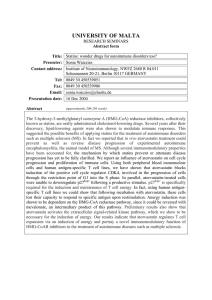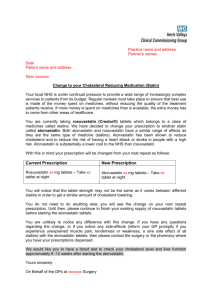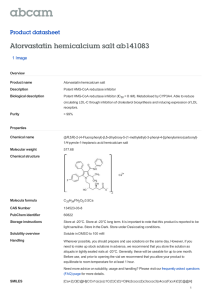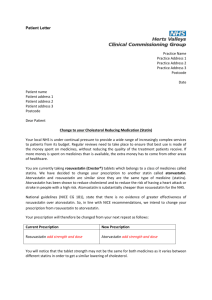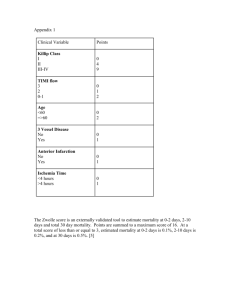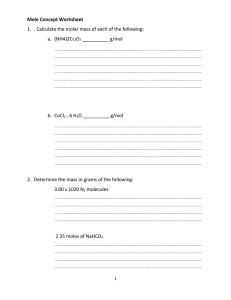Document 13308281
advertisement
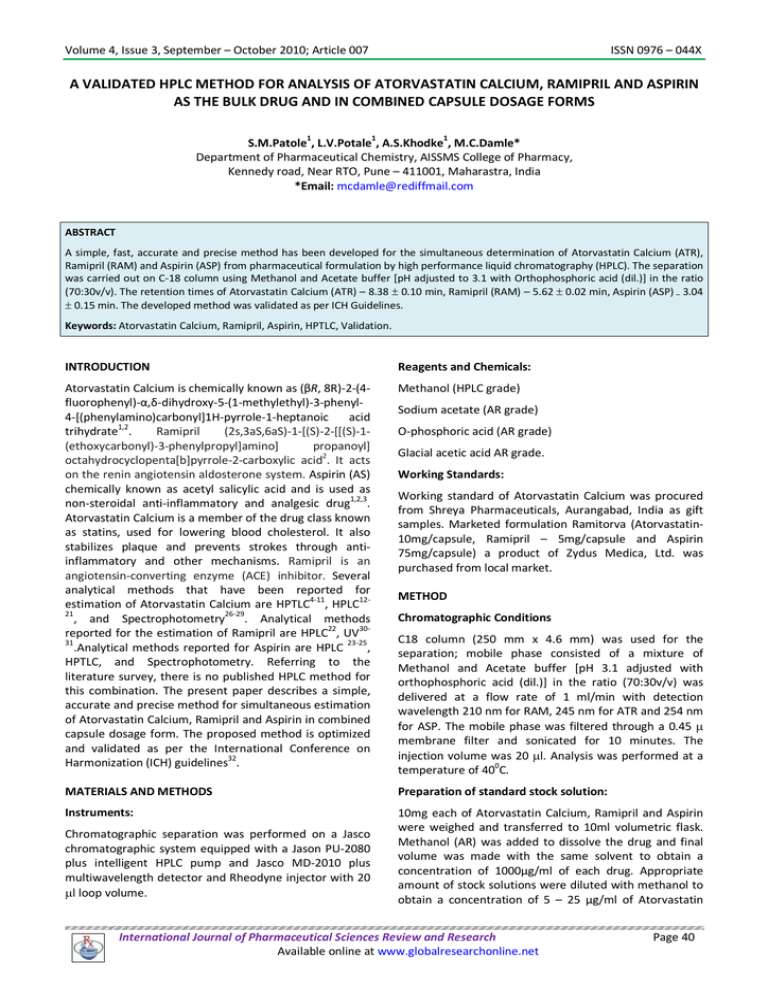
Volume 4, Issue 3, September – October 2010; Article 007 ISSN 0976 – 044X A VALIDATED HPLC METHOD FOR ANALYSIS OF ATORVASTATIN CALCIUM, RAMIPRIL AND ASPIRIN AS THE BULK DRUG AND IN COMBINED CAPSULE DOSAGE FORMS S.M.Patole1, L.V.Potale1, A.S.Khodke1, M.C.Damle* Department of Pharmaceutical Chemistry, AISSMS College of Pharmacy, Kennedy road, Near RTO, Pune – 411001, Maharastra, India *Email: mcdamle@rediffmail.com ABSTRACT A simple, fast, accurate and precise method has been developed for the simultaneous determination of Atorvastatin Calcium (ATR), Ramipril (RAM) and Aspirin (ASP) from pharmaceutical formulation by high performance liquid chromatography (HPLC). The separation was carried out on C-18 column using Methanol and Acetate buffer [pH adjusted to 3.1 with Orthophosphoric acid (dil.)] in the ratio (70:30v/v). The retention times of Atorvastatin Calcium (ATR) – 8.38 0.10 min, Ramipril (RAM) – 5.62 0.02 min, Aspirin (ASP) – 3.04 0.15 min. The developed method was validated as per ICH Guidelines. Keywords: Atorvastatin Calcium, Ramipril, Aspirin, HPTLC, Validation. INTRODUCTION Reagents and Chemicals: Atorvastatin Calcium is chemically known as (βR, 8R)-2-(4fluorophenyl)-α,δ-dihydroxy-5-(1-methylethyl)-3-phenyl4-[(phenylamino)carbonyl]1H-pyrrole-1-heptanoic acid trihydrate1,2. Ramipril (2s,3aS,6aS)-1-[(S)-2-[[(S)-1(ethoxycarbonyl)-3-phenylpropyl]amino] propanoyl] octahydrocyclopenta[b]pyrrole-2-carboxylic acid2. It acts on the renin angiotensin aldosterone system. Aspirin (AS) chemically known as acetyl salicylic acid and is used as non-steroidal anti-inflammatory and analgesic drug1,2,3. Atorvastatin Calcium is a member of the drug class known as statins, used for lowering blood cholesterol. It also stabilizes plaque and prevents strokes through antiinflammatory and other mechanisms. Ramipril is an angiotensin-converting enzyme (ACE) inhibitor. Several analytical methods that have been reported for estimation of Atorvastatin Calcium are HPTLC4-11, HPLC1221 26-29 , and Spectrophotometry . Analytical methods reported for the estimation of Ramipril are HPLC22, UV3031 23-25 .Analytical methods reported for Aspirin are HPLC , HPTLC, and Spectrophotometry. Referring to the literature survey, there is no published HPLC method for this combination. The present paper describes a simple, accurate and precise method for simultaneous estimation of Atorvastatin Calcium, Ramipril and Aspirin in combined capsule dosage form. The proposed method is optimized and validated as per the International Conference on Harmonization (ICH) guidelines32. Methanol (HPLC grade) MATERIALS AND METHODS Preparation of standard stock solution: Instruments: 10mg each of Atorvastatin Calcium, Ramipril and Aspirin were weighed and transferred to 10ml volumetric flask. Methanol (AR) was added to dissolve the drug and final volume was made with the same solvent to obtain a concentration of 1000µg/ml of each drug. Appropriate amount of stock solutions were diluted with methanol to obtain a concentration of 5 – 25 µg/ml of Atorvastatin Chromatographic separation was performed on a Jasco chromatographic system equipped with a Jason PU-2080 plus intelligent HPLC pump and Jasco MD-2010 plus multiwavelength detector and Rheodyne injector with 20 l loop volume. Sodium acetate (AR grade) O-phosphoric acid (AR grade) Glacial acetic acid AR grade. Working Standards: Working standard of Atorvastatin Calcium was procured from Shreya Pharmaceuticals, Aurangabad, India as gift samples. Marketed formulation Ramitorva (Atorvastatin10mg/capsule, Ramipril – 5mg/capsule and Aspirin 75mg/capsule) a product of Zydus Medica, Ltd. was purchased from local market. METHOD Chromatographic Conditions C18 column (250 mm x 4.6 mm) was used for the separation; mobile phase consisted of a mixture of Methanol and Acetate buffer [pH 3.1 adjusted with orthophosphoric acid (dil.)] in the ratio (70:30v/v) was delivered at a flow rate of 1 ml/min with detection wavelength 210 nm for RAM, 245 nm for ATR and 254 nm for ASP. The mobile phase was filtered through a 0.45 membrane filter and sonicated for 10 minutes. The injection volume was 20 l. Analysis was performed at a temperature of 400C. International Journal of Pharmaceutical Sciences Review and Research Available online at www.globalresearchonline.net Page 40 Volume 4, Issue 3, September – October 2010; Article 007 ISSN 0976 – 044X Calcium, 5 – 25 µg/ml of Ramipril and 10 – 50 µg/ml of Aspirin. calibration curves were plotted of area against concentration of drug. Linear regression data for calibration curves depicted in Table 4. Method development: Different columns (C8 HiQ-Sil 250 x 4.6mm, C18 HiQ-Sil 250 x 4.6mm) were tried for the chromatographic run. The acceptable elution pattern or adequate resolution could not be obtained. Different mobile phases containing Acetate buffer, Phosphate buffer, Methanol and Acetonitrile in different ratio, and various pH were tried and finally Methanol : Acetate buffer [pH 3.1 adjusted with orthophosphoric acid (dil.)] in the ratio (70:30 v/v) was selected as an appropriate mobile phase that resulted in good resolution and acceptable system suitability parameters for ATR, RAM and ASP. Procedure for Analysis of Capsule Formulation Ten capsules were weighed and finely powered. An accurately weighed powder sample equivalent to 10 mg of ATR, 5 mg of RAM and 75 mg of ASP was transferred to 10 ml volumetric flask; 7 ml of methanol was added and the flask was sonicated for 10 mins. The volume was then made up to the mark with methanol and solution was filtered through whatman filter paper No. 41.From the prepared solution, 1 ml of the filtrate was transferred to 10 ml volumetric flask, and volume was made up to the mark using mobile phase to get final concentration of 10 g/ml(For ATR,RAM). After setting the chromatographic conditions and stabilizing the instrument to obtain a steady baseline, the capsule sample solution was injected. Chromatogram was obtained and peak areas were recorded. The peak area was calculated for ATR, RAM and ASP and amount was calculated from respective calibration curves. Procedure was repeated six times for analysis of homogeneous sample. The results of analysis obtained are depicted in Table 5. II) Method validation: i) Specificity: A blank solution (mobile phase) was injected and the chromatogram showed no inferring peaks at retention time of the three drugs. The chromatogram of ATR, RAM and ASP extracted from the capsule were compared with those acquired from ATR, RAM and ASP standards, correlation was good (in terms of TR and area) indicates specificity of method. ii) Linearity and range: Aliquots 0.5-2.5 ml of ATR, 0.5-2.5 ml of RAM and 1.0-5.0 ml of ASP were transferred in series of 10 ml calibrated volumetric flasks and volume was made up to the mark with methanol. Each solution was injected and chromatogram was recorded. Linearity was evaluated by determining five standard working solutions each in triplicate for HPLC. The ATR, RAM and ASP showed good correlation coefficient in concentration range of 5-25 2 2 µg/ml (r = 0.9901), 5-25 µg/ml (r = 0.9913) and 10-50 2 µg/ml (r = 0.9914) respectively. The peak area was calculated for ATR, RAM and ASP and respective iii) Accuracy: To check the accuracy of the method, recovery studies were carried out by addition of standard drug solution to pre-analyzed sample solution at three different levels 80 %, 100 % and 120 %. In 100 % recovery study for ATR, amount of standard drug solution added was 10 µg/ml, and in 80 % and 120 % recovery study the amount of standard drug solution added was 8 µg/ml and 12 µg/ml of respectively. In the same manner, recovery studies were carried out by addition of standard drug solution to pre-analyzed sample solution at three different levels 80 %, 100 % and 120 %. In 100 % recovery study for RAM, amount of standard drug solution added was 5 µg/ml, and in 80 % and 120 % recovery study the amount of standard drug solution added was 4 µg/ml and 6 µg/ml of respectively. In 100 % recovery study for ASP, amount of standard drug solution added was 75 µg/ml, and in 80 % and 120 % recovery study the amount of standard drug solution added was 60 µg/ml and 90 µg/ml of respectively. Samples were injected and peak areas were obtained. Amount of drug recovered was calculated from calibration curve. At each levels of the amount, three determinations were performed. The results obtained have been depicted in Table 3, 4 and 5. Precision iv) Method precision: The precision of the method was demonstrated by interday and intraday precision studies. For the intraday precision, injections of the three mixed standard solutions were repeated thrice in a day and % RSD was calculated. In the interday studies, injection for standard solutions was made on 3 consecutive days and % RSD was calculated. The interday % RSD for ATR, RAM and ASP. From the data obtained, the developed RP-HPLC method was found to be precise. v) Limit of detection (LOD): The Limit of Detection (LOQ) is the smallest concentration that can be detected but not necessarily quantified as an exact value.LOD can be calculated as: LOD = 3.3 /S Where = Standard deviation of the response (y- intercept) S = Slope of the calibration curve vi) Limit of quantification (LOQ): The Limit of Quantitation (LOQ) is the lowest amount of analyte in the sample that can be quantitatively determined with suitable precision and accuracy. LOQ = 10 /S International Journal of Pharmaceutical Sciences Review and Research Available online at www.globalresearchonline.net Page 41 Volume 4, Issue 3, September – October 2010; Article 007 Where = Standard deviation of the response (y- intercept) S = Slope of the calibration ISSN 0976 – 044X correlation was good (in terms of RT and Area) indicates specificity of the method. No any interference of the additives was found. Thus,it was concluded that, there is no interferring peak at the Rt of all three drugs. vii) Specificity: viii) Robustness: The specificity is the ability to access unequivocally the analyte in the presence of components which may be expected to be present. A blank solution (mobile phase) was injected and the chromatogram showed no interferring peaks at the retention time of the three drugs. The chromatogram of ATR, RAM and ASP extracted from the capsule dosage form were compared with those acquired from standards of ATR, RAM and ASP, The robustness of a method is its ability to remain unaffected by small deliberate changes in parameters. Robustness of the method was determined by carrying out the analysis under conditions during which wavelength was changed. Variation is seen to have impact on the resolution than other parameters and hence should be controlled. No significant change was found in the AUC value. Figure 1: A Representative Chromatogram of Aspirin, Ramipril and Atorvastatin Calcium at 210 nm Retention time of each drug: Aspirin (10mcg/ml): 3.08; Ramipril (5mcg/ml): 5.80; Atorvastatin Calcium (5 mcg/ml): 8.20 Table 1: Recovery studies of ATR Expected Conc. of Sample Level of Recovery 80% 100% 120% Peak area . 8 µg/ml 10 µg/ml 12 µg/ml Replicate 1 689219 943124 1231529 Replicate 2 684391 940498 1231218 Replicate 3 683219 930283 1231153 Mean 685609.7 937968.3 1231300 % RSD 0.4638 0.7231 0.0162 Mean conc. Found 14.26 19.88 26.29 Mean % recovery 79.24 99.13 119.55 International Journal of Pharmaceutical Sciences Review and Research Available online at www.globalresearchonline.net Page 42 Volume 4, Issue 3, September – October 2010; Article 007 ISSN 0976 – 044X Table 2: Recovery studies of RAM Expected Conc. of Sample Level of Recovery 80% 100% 120% Peak area 4 µg/ml 5µg/ml 6 µg/ml Replicate 1 347955 453894 586124 Replicate 2 346891 454231 589961 Replicate 3 347423 453621 584929 Mean 347423 453915.3 587004.2 % RSD 0.1531 0.0671 0.4418 Mean conc. Found 7.23 9.84 13.11 Mean % recovery 80.33 98.47 119.18 Table 3: Recovery studies of ASP Expected Conc. of Sample Level of Recovery 80% 100% 120% Peak area 60 µg/ml 75µg/ml 90 µg/ml Replicate 1 5429629 7842591 10403129 Replicate 2 5430198 7831265 10402198 Replicate 3 5431653 7838744 10401168 Mean 5430493 7837542 10402165 % RSD 0.0192 0.0734 0.0942 Mean conc. Found 106.26 150.03 197.85 Mean % recovery 78.71 100.02 119.21 Table 4: Linear regression data of ATR, RAM and ASP Sr.no Parameters ATR RAM ASP 1 Detection Wavelength (nm) 245 210 254 2 Linear Range (g/ml) 5-25 5-25 10-50 2 3 Correlation Coefficient (r ) 0.9901 0.9913 0.9914 4 Linear Regression Equation (y = mx + c) y = 45373x+38122 2 R = 0.9901 y = 40734x+52753 2 R = 0.9913 y= 54316x-344834 2 R = 0.9914 5 LOD 0.51 0.17 2.29 6 LOQ 1.55 0.52 6.96 Table 5: Analysis of Tablet Formulation Sr. no. Parameters 1 Drug ATR RAM ASP Label claim (mg/tab.) 10 MG 5 MG 75 MG 2 Drug content (%) 99.13 98.47 100.02 3 %RSD 0.7231 0.0671 0.0734 International Journal of Pharmaceutical Sciences Review and Research Available online at www.globalresearchonline.net Page 43 Volume 4, Issue 3, September – October 2010; Article 007 ISSN 0976 – 044X Calcium and Ezetimibe, Pharm.Sci.2006:793-796 RESULTS AND DISCUSSION The proposed method was found to be simple and sensitive with linearity in the concentration range of 5 25 g/ml for ATR, 5 – 25 g/ml for RAM and 10 – 50 g/ml for ASP. The method was found to be accurate and precise as indicated by results of recovery studies and %RSD not more than 2%. LOD and LOQ for Atorvastatin Calcium were found to be 0.437 g/ml and 1.430 g/ml respectively and for Ramipril were 0.284 g/ml and 0.861 g/ml respectively. The proposed method was found to be specific as there is no interference from common capsule excipients like lactose, starch etc. and Peak purity values for peaks of both ATV, RAM and ASP confirmed the specificity. CONCLUSION The developed RP-HPLC method for the simultaneous determination of Atorvastatin Calcium, Ramipril and Aspirin can be used for routine analysis of both these components in combined dosage form. Acknowledgement: The author expresses their gratitude to the AISSMS College of Pharmacy, Pune, for providing the research facility and also the M/s. Shreya Pharmaceuticals, Ltd. Aurangabad, for providing the drug samples. REFERENCES 1. Indian Pharmacopoeia 1996, Published by the Controller of Publications, Delhi, Government of India, Ministry of Health and Family Welfare Volume I & II,69, 486,749, 1574. 2. Indian Pharmacopoeia 2007, Published by the Government of India, Ministry of Health and Family Welfare, the Indian Pharmacopoeia commission, New Delhi Volume I & II,131,1036 3. British Pharmacopoeia 2007 Published by the Stationary office, on behalf of the Medicine and Healthcare products, 4. 5. 6. Dhaneshwar SS,Dhaneshwar SR,Deshpande P,Patil M,Development and Validation of a method for simultaneous densitometric estimation of Atorvastatin Calcium and Ezetimibe as the bulk drug and in tablet dosage form,Acta Chromatographica,Vol.19,2007,141-148 Deshpande PB,Shridharan G,Anandi L,Jadhav D,Damle MC,Gandhi SV,Validated method development for estimation of Atorvastatin Calcium and Fenofibrate in fixed dose combination by HPTLC,Pharma Review, May 2009,151-153. Chaudhari BG,Patel NM,Shah PB,Modi KP,Development and Validation of a HPTLC method for the simultaneous estimation of Atorvastatin Indian Journal of 7. Kowalczuk D, Pietra R, Hopka H, Development and Validation of an HPTLC –Densitometric method for the determination of ACE inhibitors, Chromatographia, Volume 60,245-249. 8. Panchal HJ,Suhagia BN,Patel NJ,Simultaneous HPTLC analysis of Atorvastatin Calcium,Ramipril and Aspirin in capsule dosage form,JPC-Journal of Planar Chromatography,Vol.22,265-271 9. Gupta KR,Wankhede SB,Tajne MR, Simultaneous determination of Amlodipine and Ramipril by High Performance Thin Layer Chromatography, Asian Journal of Chemistry,Vol.19,2007,4177-82 10. Damle MC,Sinha PK,Bothra KG,A validated stability indicating HPTLC method for the determination of Aspirin and Clopidrogrel bisulphate in combined dosage form, Eurasian journal of Analytical Chemistry,Vol.4,2009,152-160 11. Suvillan C,Sherma J,Determination of Salicylamide in pharmaceutical tablets by HPTLC with UV absorption densitometry,Acta Chromatographica,No.16,153-164. 12. Mohammadi A,Rezanour N,Ansari Dogaheh M,Ghorbani Bidkorbeh F,A stability indicating HPLC assay for the simultaneous determination of Atorvastatin and Amlodipine in commercial tablets, Journal of Chromatography B,846(2007),215-221. 13. Shah DA,Bhatt KK,Mehta RS,Shankar MB,RP-HPLC method for the determination of Atorvastatin Calcium and Nicotinic acid in combined tablet dosage form, Indian Journal of Pharm.Sci.,69(5)2007,700-703. 14. Shah DA,Bhatt KK,Mehta RS,Shankar MB,Baldania SL,Development and Validation of an RP-HPLC method for the determination of Atorvastatin Calcium and Aspirin in capsule dosage form, Indian Journal of Pharm.Sci.,69(4)2007,546-549 15. Jain N,Raghuvanshi R,Jain D,Development and Validation of RP-HPLC method for the simultaneous estimation of Atorvastatin Calcium and Fenofibrate in tablet dosage forms, Indian Journal of Pharm.Sci.,70(2)2008,263-265. 16. Raja Rajeshwari K,Sankar GG,Rao AL,RP-HPLC method for the simultaneous determination of Atorvastatin and Amlodipine in tablet dosage form, Indian Journal of Pharm.Sci.,68(2)2006,275-277. 17. Petkovska R, Comett C, Dimitrovska A, Development and Validation of Rapid Resolution RP-HPLC method for simultaneous determination of Atorvastatin and related compounds by use of chemometrics, Analytical letters, 41(6), April 2008, 992-1009. International Journal of Pharmaceutical Sciences Review and Research Available online at www.globalresearchonline.net Page 44 Volume 4, Issue 3, September – October 2010; Article 007 ISSN 0976 – 044X 18. Stanisz B, Kania L, Validation of HPLC method for determination of Atorvastatin in tablets and for monitoring stability in solid phase, Acta Poloniae Pharmaceutica, 63(6), 2006, 471-476. 25. Montgomery ER,Taylor S,Segretario J,Engler E,Development and Validation of RP-HPLC method for Analysis of Aspirin and Warfarin in combination, Journal of Pharmaceutical and Biomedical Analysis,15,1996,73-82. 19. Chaudhari BG, Patel NM, Shah PB,Patel LJ, Stability indicating reversed phase liquid chromatographic method for simultaneous determination of Atorvastatin and Ezetimibe from their combination drug products,90(6),Nov.2007,1539-1546. 20. Zahid Z,Farooqui MN,Mangle AA, Nikalje AG,Stability indicating HPLC determination of Atorvastatin Calcium in pharmaceutical dosage form, African Journal of Pharmacy and Pharmacology,Vol.2(10)Nov 2008,204-210. 21. Shah DA,Bhatt KK,Mehta RS,Baldania SL,Gandhi TR, Stability indicating RP-HPLC estimation of Atorvastatin Calcium and Amlodipine Besylate in Pharmaceutical Formulations, Indian Journal of Pharm.Sci.,70(6)2008,754-760. 22. Yazbi F A,Mahrous ME,Hammud HH,Songi GM,Comparitive Spectrophotometric, Spectrofluorometric, and HPLC study for the Quantitative determination of binary mixture Felodipine and Ramipril in Pharmaceutical Formulations, Analytical letters,41(5),Jan.2008, 853-870. 23. Gandimati M,Ravi TK,Abraham A, Thomas R,Simultaneous determination of Aspirin and Isosorbide 5-mononitrate in formulation by RPHPLC ,Journal of Pharmaceutical and Biomedical Analysis,32,2003,1145-1148. 24. Franeta JT,Agbaba D,Eric S,HPLC assay of acetylsalicylic acid,paracetamol,caffeine and Phenobarbitals in tablets,IL Farmaco,57,2002,709713. 26. Thamake SL,Jadhav SD,Pishawikar SA,Development and Validation of method for simultaneous estimation of Atorvastatin Calcium and Ramipril from capsule dosage form by First Order Derivative Spectroscopy, Asian J.Research Chem.2(1),Jan-Mar 2009,52-53. 27. Patil UP, Gandhi SV, Sengar MR,Rajmane VS, Simultaneous determination of Atorvastatin Calcium and Telmisartan in tablet dosage form by spectrophotometry, International Journal of ChemtechResearch,Vol.1(4),Oct-Dec.2009,970-973. 28. Baldha RG,Patel VB,Bapna M,Simultaneous spectrophotometric determination of Atorvastatin Calcium and Ezetimibe in tablet dosage form, International Journal of Chemtech Research,Vol.1(2),Apr-Jun.2009,233-236 29. Zambare YB,Karajgi SR,Simpi CC,Simultaneous estimation of Atorvastatin and Ramipril by First Derivative Spectrophotometric method, Journal of Pharmacy Research,2(5),2009,874-877. 30. Patil PR,Rakesh SU,Dhabale PN,Simultaneous Estimation of Ramipril and Amlodipine by UV Spectrophotometric method, Research J.Pharm.Tech.2(2),April-June 2009,304-307. 31. Abdelattef HE, Spectrophotometric and Spectrofluorometric methods for the determination of Ramipril in its pure and dosage form, Spectrochimica Acta PartA 66(2001),701-706. 32. ICH, Q2 (A). Validation of analytical procedures: text and methodology International Conference on Harmonization. Geneva: 2005. p: 1- 13. ************* International Journal of Pharmaceutical Sciences Review and Research Available online at www.globalresearchonline.net Page 45
